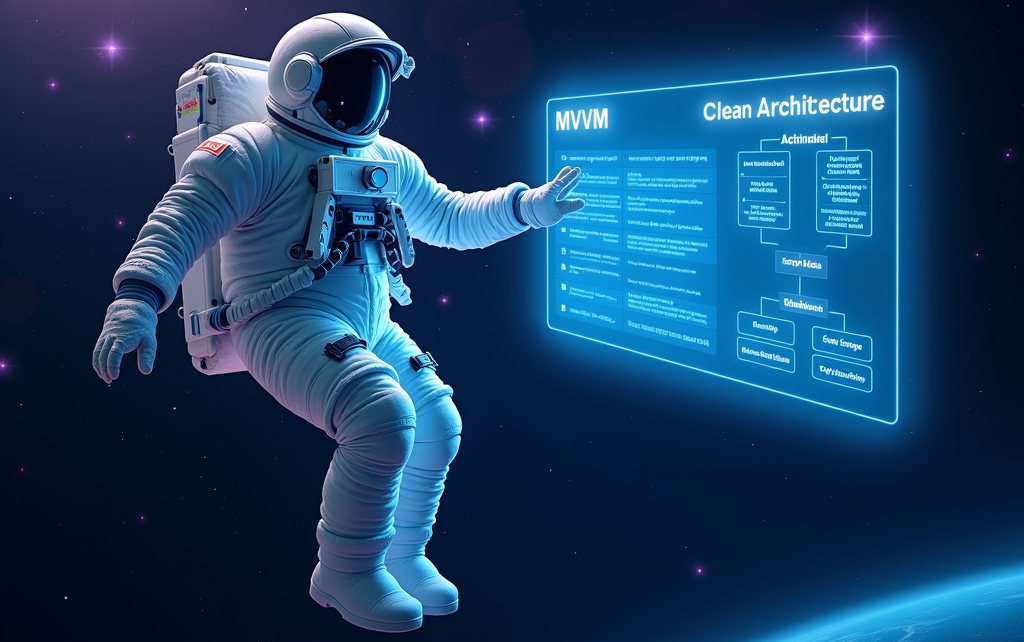The Clean Architecture pattern offers a robust framework for building software that is maintainable, testable, and highly adaptable to change. The pattern ensures that the core business logic remains unaffected by external changes and dependencies. Its separation of concerns across different layers simplifies maintenance and testing, and enhances the system's flexibility, allowing for easier integration of new technologies or adjustments to meet evolving requirements.
By following the Clean Architecture pattern, we can address and overcome various issues that could occur during software development or in an application's lifecycle, such as code duplication, tight coupling, scalability challenges, and testing complexity. Applying Clean Architecture leads to software that is easier to manage and evolve, and more resilient in the face of changing demands.
To get a detailed understanding of Clean Architecture, I recommend you take a look at our blog post Clean Architecture: A Deep Dive into Structured Software Design. Our post How Clean Architecture Solves Common Software Development Challenges is an excellent addition to this since it explains how Clean Architecture can help us address and overcome common software development issues.
While Clean Architecture provides a solid foundation for structuring an application, implementing it effectively often benefits from complementary patterns that address specific aspects of application design. One such addition is the MVVM (Model-View-ViewModel) pattern, which benefits frontend and UI-heavy applications. The MVVM pattern can enhance a Clean Architecture implementation by providing clear guidelines for separating UI concerns from business logic. This makes state management more maintainable and improves the testability of UI components.
This blog post will explore how MVVM can complement and enhance Clean Architecture implementations. First, we look at the MV* patterns in general to understand their common characteristics. We will then focus on the MVVM pattern and how it can be integrated with Clean Architecture principles to create more maintainable and testable applications.
This topic was also part of a talk I gave in 2023 on the [code.talks] conference. The talk is available as a video on YouTube. If you are interested, you can follow this link: YouTube.
MV* Patterns Overview
The MV* patterns are a family of architectural patterns with a shared goal: improving maintainability and testability by separating application concerns into distinct components. The most popular patterns in this family include Model-View-Controller (MVC), Model-View-ViewModel (MVVM), and Model-View-Presenter (MVP). All these patterns divide the application into at least two major components: the Model and the View. The asterisk in MV* represents the third component that varies across different patterns (Controller, Presenter, or ViewModel).
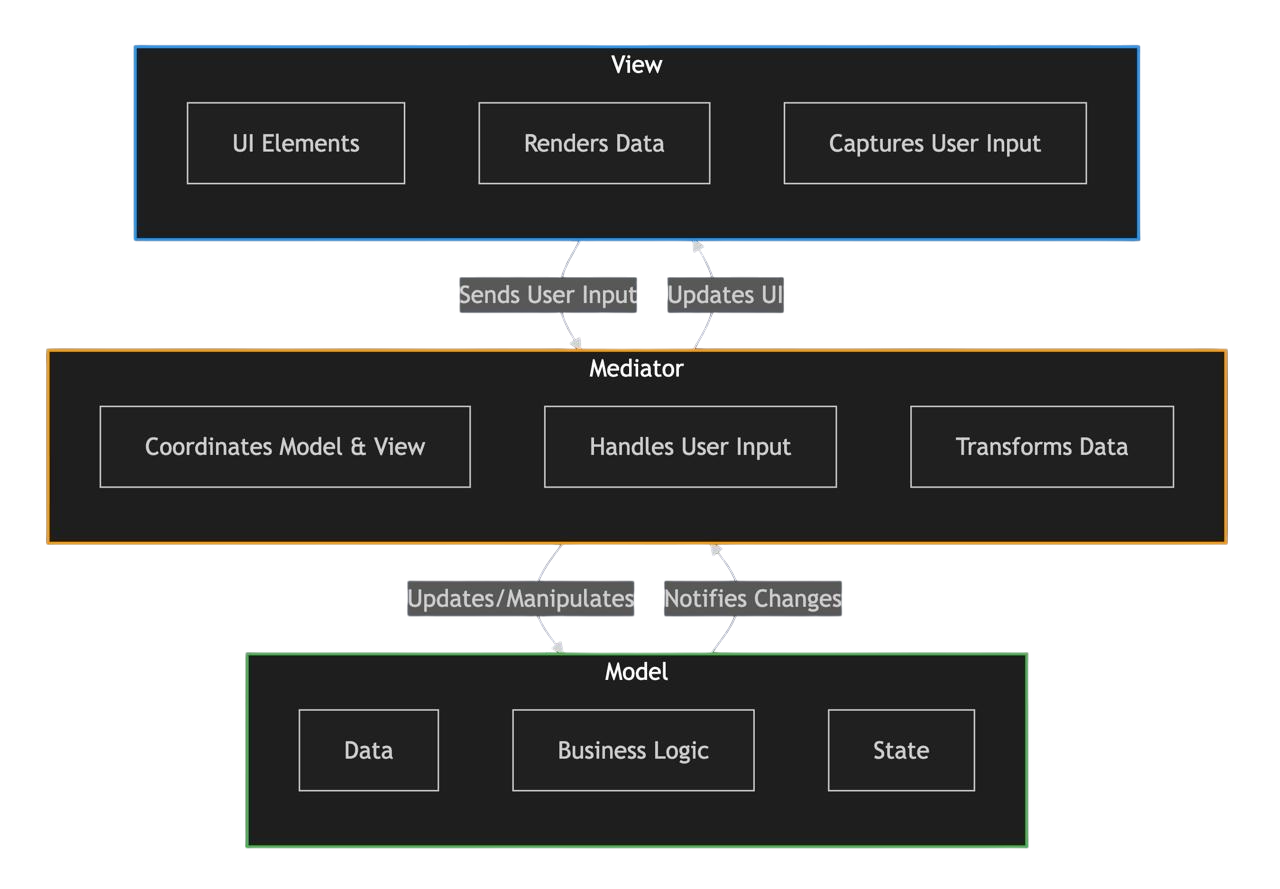
The diagram above illustrates the general structure of MV* patterns. Each pattern divides the application into three key components:
- Model: Handles data management, business logic, and state.
- View: Renders UI elements and captures user input.
- Mediator: Coordinates interactions between the
ModelandView. Depending on the pattern, this mediator could be aController,Presenter, orViewModel.
Differences in Coupling Across MV* Patterns
While all MV* patterns aim to separate concerns, their effectiveness at achieving loose coupling varies:
MVC:
- In MVC, the
Viewdirectly observes changes in theModel. This tight coupling betweenViewandModelcan make testing more challenging, especially when third-party libraries are involved (e.g., UI frameworks). - The
Controlleracts as an intermediary but is often tightly coupled with both theViewandModel, further complicating testing and maintenance.
MVP:
- MVP improves the MVC pattern by introducing a
Presenter, which decouples theViewfrom theModel. ThePresenterhandles all interactions between these components, allowing for better modularity and easier testing.
MVVM:
- The MVVM pattern takes separation even further by introducing a
ViewModel. Unlike MVC or MVP, the ViewModel has no direct reference to theView. Instead, it uses data binding mechanisms to connect UI elements (View) with data (Model). This ensures a complete decoupling between the UI and business logic, making testing easier and enhancing maintainability.
Achieving Loose Coupling with Clean Architecture Principles
Please note that the MV* patterns alone don't guarantee loose coupling. Concrete implementations can still lead to compile-time dependencies between components without proper abstraction layers or interfaces.
However, when combined with Clean Architecture principles, such as the dependency inversion principle and layered boundaries, MV* patterns can provide a solid foundation for creating maintainable and testable systems.
The MVC Pattern
The group's oldest and most widely used pattern is the MVC pattern, which was introduced in the 1970s. It separates a system into three distinct components:
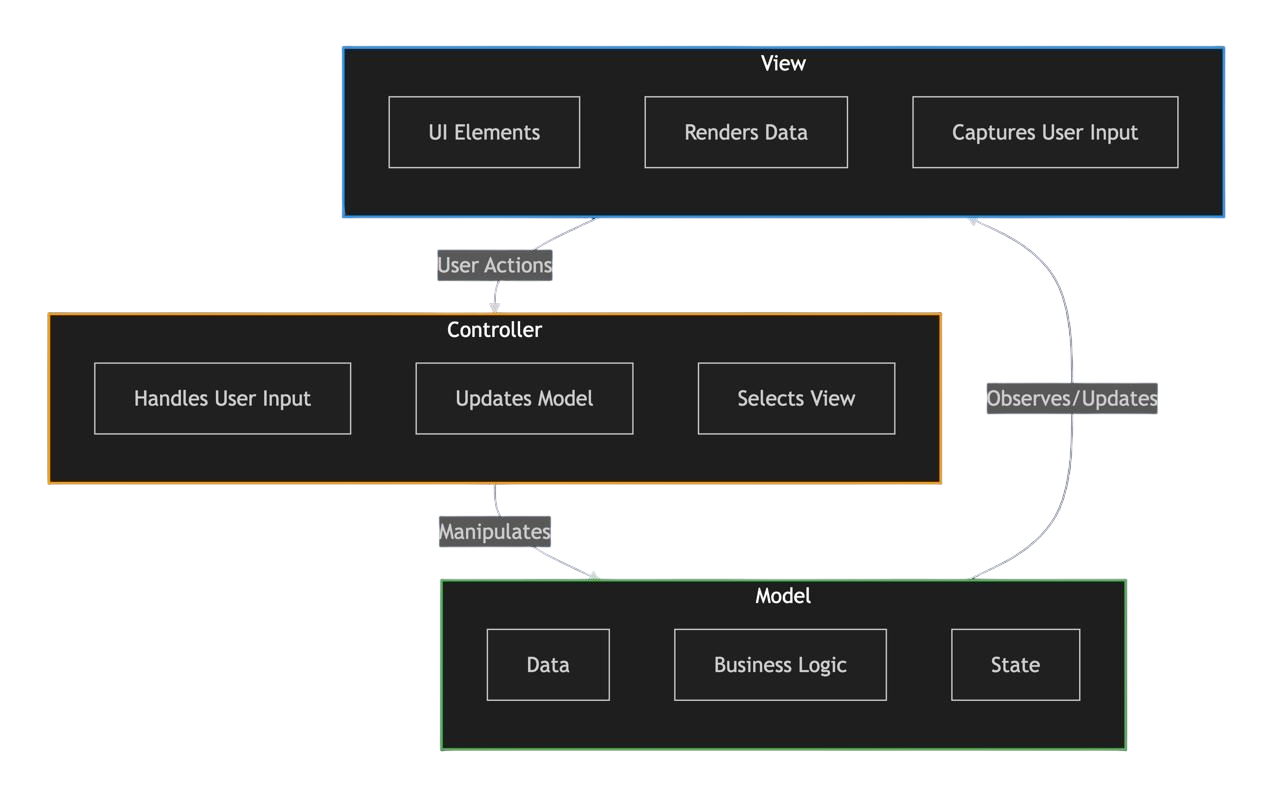
This diagram shows the MVC pattern and its flow of communication. The View sends user actions to the Controller, which then updates the Model. The Model notifies the View of changes, often through an observer pattern. This creates a relationship where the View directly observes the Model for updates. This direct observation mechanism creates a tight coupling between the View and the Model, which is one of the main disadvantages of the MVC pattern.
To summarize the components:
-
Model: The
Modelrepresents the system's data and business logic. It is responsible for storing, retrieving, and processing data, implementing business rules, and notifying theViewof changes. -
View: The
Viewdisplays the data from theModelto the user. It renders the user interface and forwards user interactions to theController. -
Controller: The
Controllerhandles the user input and updates theModeland theViewaccordingly. It acts as an intermediary between theModeland theView, processing user requests, updating theModel, and selecting the appropriateView.
While the MVC pattern provides some separation of concerns, its implementation often leads to several challenges:
-
Tight coupling between View and Model: The direct dependency between the
Viewand theModelmakes modifying one without affecting the other difficult. This can create tight dependencies. -
Testing difficulties: Since the
ViewandModelare tightly coupled, testing becomes more challenging. Unit testing theViewin isolation is complex as it directly observes theModel. -
Complex Controller logic: As applications grow,
Controllersoften become bloated with both UI and business logic.
These limitations become more apparent when comparing MVC to other MV* patterns. While MVC was innovative when introduced, modern application development often requires patterns with cleaner separation between components, especially for complex UIs and when following principles like those in Clean Architecture.
The MVVM Pattern
The MVVM pattern is a newer addition to the MV* patterns. Microsoft introduced it in the early 2000s as part of their Windows Presentation Foundation (WPF) framework. It is an evolution of the MVC pattern that replaces the Controller with a new ViewModel component. The ViewModel provides a cleaner separation between UI and business logic. This design pattern consists of three primary components: Model, View, and ViewModel.
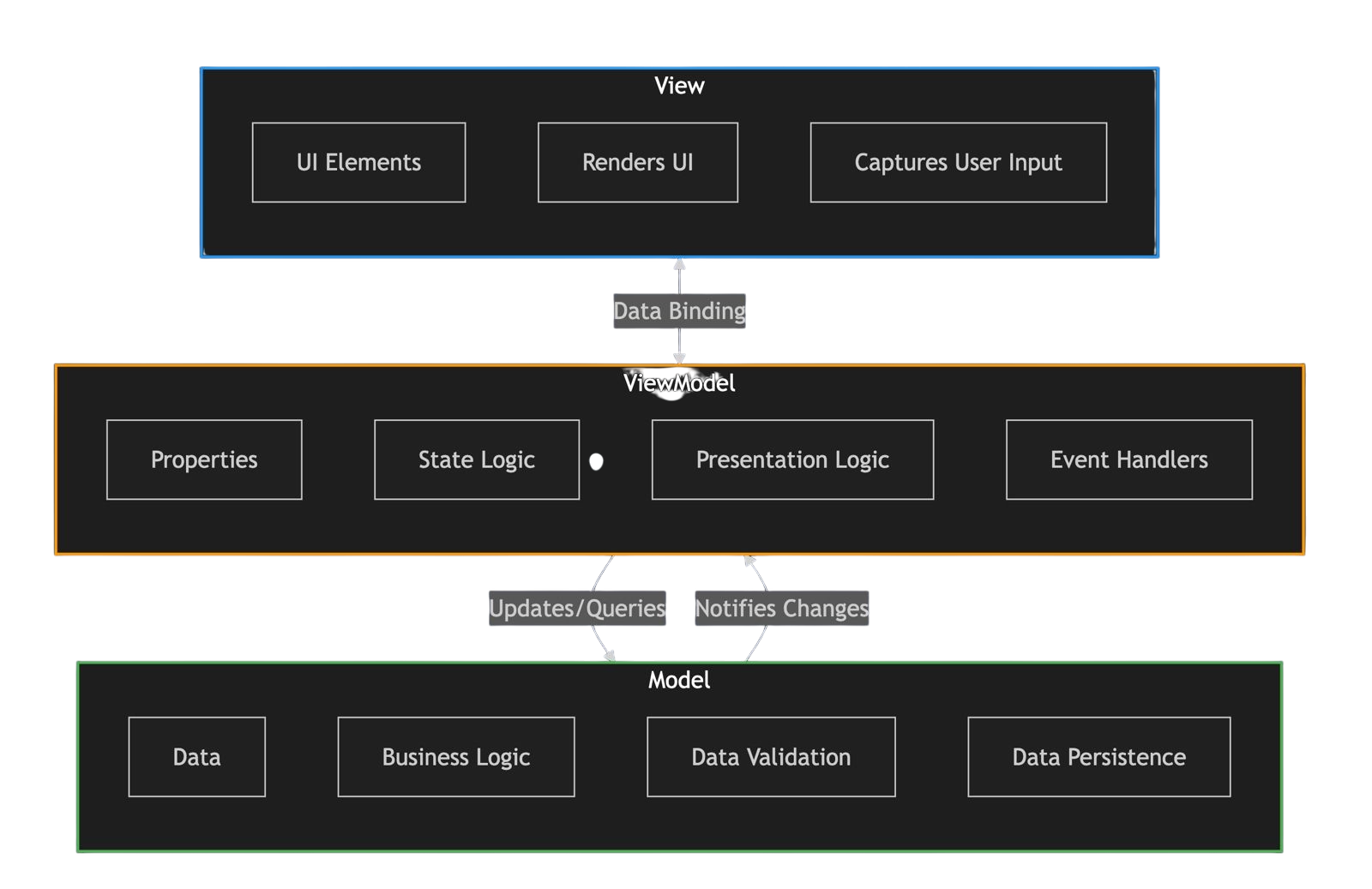
The diagram illustrates the MVVM pattern's structure and communication flow. Unlike MVC, MVVM uses data binding to connect the View and ViewModel. This creates complete separation, as the View has no knowledge of the Model, and the ViewModel operates independently of any specific View. The ViewModel doesn't reference or depend on the View, allowing different Views to use the same ViewModel without requiring changes to its implementation. The ViewModel acts as an intermediary that transforms data from the Model into a format suitable for the View and handles user interactions from the View.
To summarize the components:
-
Model: The
Modelrepresents the system's data and business logic. It is responsible for storing and managing the data, implementing business rules, and providing data validation and persistence. -
View: The
Viewis responsible for displaying the data to the user and sending any user input back to theViewModel. It defines the structure, layout, and appearance of what the user sees on the screen. -
ViewModel: The
ViewModelacts as a bridge between theModeland theView. It exposes the data from theModelto theView, handles user interactions, and processes them into actions on theModel. TheViewModeldoesn't have any direct reference to theView, which makes it possible to test theViewModelindependently from theView.
The most important characteristic of MVVM is that it uses data bindings to connect the View and the ViewModel. Data bindings provide a way to connect the user interface elements in the View to the data in the ViewModel. When the data in the ViewModel changes, the UI automatically updates to reflect those changes. Likewise, when the user interacts with the UI, those interactions can automatically update the data in the ViewModel. This allows a clean separation between UI design and business logic.
Another feature of the MVVM pattern is the use of event handlers. These encapsulate the logic for responding to user interactions, allowing the View to trigger business logic without knowing the implementation details.
Compared to the MVC pattern, MVVM offers several key advantages that make it particularly well-suited for a Clean Architecture implementation:
Communication Flow:
- In MVC, the
Viewsends user actions to theController, which updates theModel. TheModelthen notifies theViewof changes directly, creating tight coupling. - In MVVM, the
ViewandViewModelare connected through data binding, providing a more automatic and bidirectional data flow without direct dependencies.
View-Model Relationship:
- In MVC, the
Viewoften directly observes theModelfor changes, creating tight coupling. - In MVVM, the
Viewhas no direct knowledge of theModel; it only interacts with theViewModelthrough data binding, maintaining loose coupling.
Testability:
- MVVM offers significantly better testability as the
ViewModelhas no dependency on theView, making it easier to test in isolation. - MVC's
Controlleris tightly coupled with both theViewandModel, making testing more challenging.
UI Logic:
- In MVVM, presentation logic is placed in the
ViewModel, keeping theViewfocused purely on UI rendering. - In MVC, the
Controllerhandles user input, but some UI logic may end up in theView.
Why MVVM Complements Clean Architecture
You may now ask yourself how the MVVM pattern complements a Clean Architecture implementation and what benefits this combination provides. Let us examine how these two architectural approaches work together:
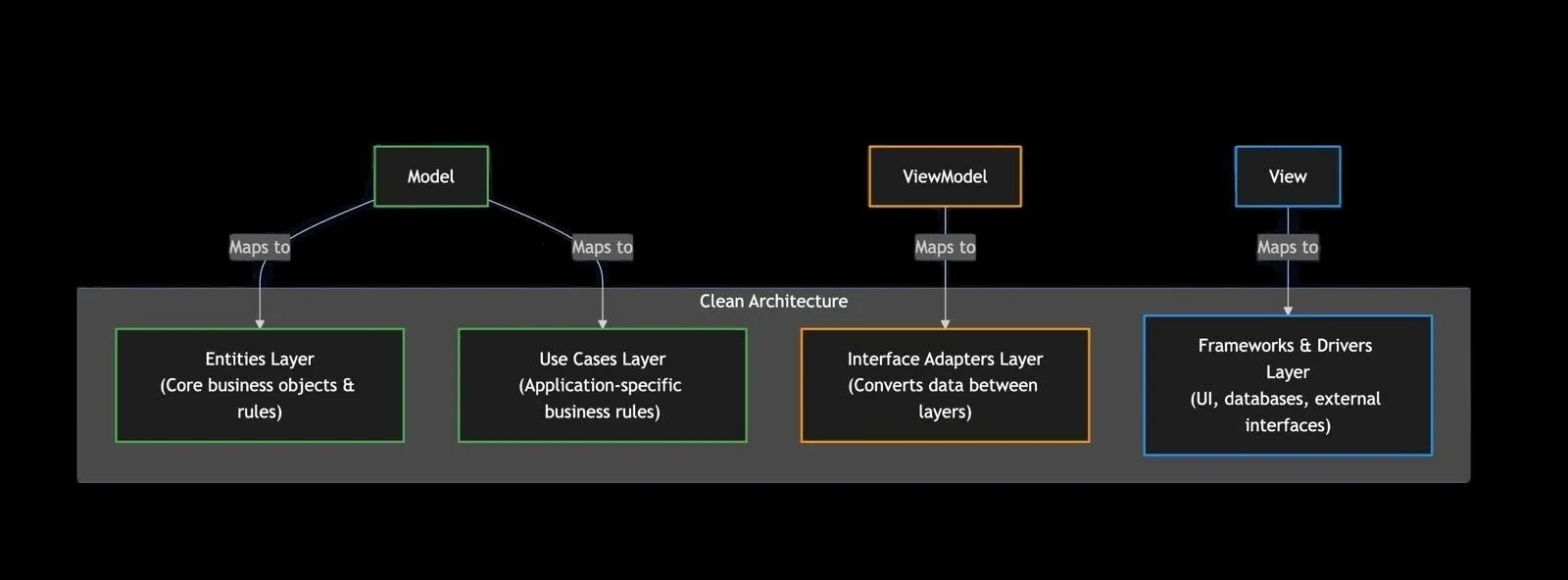
This diagram illustrates how MVVM components align with Clean Architecture layers. The diagram contains brief descriptions for each Clean Architecture layer to give you a basic understanding of each layer's responsibility. For a more comprehensive explanation of these layers, please refer to our blog post Clean Architecture: A Deep Dive into Structured Software Design. The mapping shows:
- The
Modelcomponent of MVVM spans both theEntitiesandUse Caseslayers, handling domain objects and business operations. - The
ViewModelserves as anInterface Adapter, transforming data between the core business logic and the UI. - The
Viewcomponent is limited to theFrameworks & Driverslayer.
This alignment creates a design where MVVM's separation of concerns complements Clean Architecture's layered boundaries.
MVVM provides several benefits when implementing Clean Architecture principles:
-
Enhanced Separation of Concerns
MVVM promotes a clear separation between UI (
View), presentation logic (ViewModel), and underlying data and business rules (Model). This separation makes the code more modular and easier to maintain, aligning with Clean Architecture's emphasis on separating concerns across different layers. -
Improved Testability
The decoupling of components in MVVM facilitates testing in isolation. The
ViewModelcan be tested without theView, and theModelcan be tested independently of both. This supports Clean Architecture's goal of creating a system where individual components can be developed, tested, and maintained independently without affecting the entire application. -
Centralized State Management
The
ViewModelcentralizes presentation logic and UI state management, providing a single source of truth for the UI. At first glance, this might seem contradictory to its role as anInterface Adapter, but these roles are complementary.As an
Interface Adapter, theViewModeltransforms domain data from theModelinto UI-friendly formats. This transformation process is the first step in UI state management: creating a presentation-ready representation from domain data. TheViewModelthen maintains this transformed representation and manages state transitions triggered by user interactions.This boundary position between business logic and UI is ideal for UI state management because:
- It isolates UI state concerns from domain logic
- It prevents UI state implementation details from leaking into core business rules
- It creates a clear boundary where data crosses from domain representation to presentation representation
In Clean Architecture, the state is managed at different layers with a clear separation of concerns:
- Domain state is managed within the
Use CasesandEntitieslayers - UI state is managed at the boundary in the
Interface Adapterslayer (by components likeViewModels)
The
ViewModeldoesn't manage the domain state (which remains the responsibility of the inner layers); instead, it manages how domain data is represented to users and how user interactions affect the presentation. -
Compatibility with Dependency Inversion
While not a feature of MVVM, the pattern's structure makes it compatible with dependency injection practices.
ViewModelscan easily receive services, repositories, and use cases as dependencies without creating tight coupling to specific implementations. This compatibility allows developers to apply Clean Architecture's Dependency Inversion Principle, where high-level modules and low-level modules depend on abstractions rather than concrete implementations. -
Framework Independence
The
ViewModelandModelcomponents of MVVM are independent of UI frameworks, which aligns with Clean Architecture's goal of creating systems where business logic is isolated from external dependencies. This independence makes adapting to changing UI technologies easier without affecting the core business logic.
When mapping MVVM to Clean Architecture layers:
- Entities Layer: Contains the core business objects and business rules. In MVVM, these elements are incorporated into the
Modelcomponent, representing the domain's essential data structures and behaviors. - Use Cases Layer: Contains application-specific business rules. In MVVM, these would also be part of the
Modelcomponent, focusing on business operations and orchestration. - Interface Adapters Layer: Converts data between formats, transforming from the structure used by the core business logic (
EntitiesandUse Cases) into formats optimized for display or external systems. TheViewModelin MVVM serves this purpose, processing raw business data from theModelinto a presentation-ready format that theViewcan easily consume and display. - Frameworks & Drivers Layer: Contains frameworks and tools like the UI, databases, and external interfaces. The
Viewcomponent of MVVM belongs in this layer, handling UI rendering and user input.
By using MVVM alongside Clean Architecture, you create a more comprehensive approach to frontend development. Clean Architecture provides the overall structure and principles for organizing the application's layers and dependencies. MVVM, on the other hand, offers specific guidelines for handling the presentation layer and user interface concerns.
Specifically, MVVM provides:
- A clear separation between UI (
View) and business logic (Model) - A dedicated component (
ViewModel) for managing UI state and presentation logic - A mechanism (data binding) for efficiently updating the UI based on changes in the underlying data
These MVVM concepts align well with Clean Architecture principles while offering concrete patterns for implementing the user interface layer. This combination allows developers to maintain Clean Architecture's core ideas of separation of concerns and independence of core business logic while having a clear structure for organizing and implementing complex UI-related code in modern applications.
For a practical implementation example, you can look forward to our upcoming blog post, "Developing a Clean Architecture-inspired React Application with MVVM", which will guide you through creating such an application step by step.
Conclusion
The MVVM pattern is complementary when implementing Clean Architecture principles, particularly for frontend and UI-heavy applications. Its emphasis on separating concerns aligns well with Clean Architecture's goal of creating software that is maintainable, testable, and adaptable to change. By dividing an application into Model, View, and ViewModel, MVVM allows for a modular design where each component can be developed and tested in isolation, enhancing the overall quality and robustness of the application.
The ViewModel, which bridges the View and the Model, centralizes the presentation logic and ensures that the UI (View) remains decoupled from the business logic and data (Model). This separation contributes to easier maintenance and allows for greater flexibility when integrating new technologies or adjusting to evolving requirements.
Key benefits of using MVVM alongside Clean Architecture include:
- Enhanced separation of UI concerns: MVVM provides clear guidelines for separating UI rendering from presentation logic and business rules.
- Improved testability: The decoupling of components makes it easier to test each part in isolation, especially the
ViewModel, which contains most of the presentation logic. - Centralized state management: The
ViewModelprovides a single source of truth for the UI state, making applications more predictable and easier to debug. - Framework independence: The core business logic remains isolated from UI frameworks, allowing one to change UI technologies with minimal impact on your application's core.
When implementing Clean Architecture, MVVM isn't a requirement, but it can be a valuable tool that helps us maintain clean boundaries, especially in the presentation layer. By understanding how MVVM components map to Clean Architecture layers, we can create applications that are not only functional in the short term but also sustainable and adaptable to future needs.



